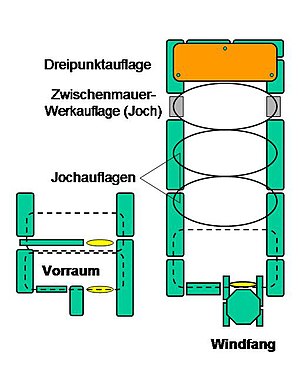Großdolmen von Dwasieden
Location of the grave on Rügen |
The Großdolmen of Dwasieden , a district of Sassnitz , is located on the Jasmund peninsula on the island of Rügen in Mecklenburg-Western Pomerania . It was excavated by Ewald Schuldt in 1970 and bears the Sprockhoff number. 472. The megalithic system of the funnel beaker culture (TBK) was created between 3500 and 2800 BC. “Neolithic monuments are an expression of the culture and ideology of Neolithic societies. Their origin and function are considered to be the hallmarks of social development ”.
The complex was painted in 1806 by the Greifswald- born painter Caspar David Friedrich (1774–1840). The drawings and sketches are in the Ashmolean Museum of Art & Archeology at Oxford .
description
The Großdolmen is located near the southwestern edge of the forest south of the Lancken district, less than 500 m from the Baltic Sea. It lies in an approximately northeast-southwest-oriented, trapezoidal boggy bed about 35 m long and 12.5 or 7.5 m wide. Of the 54 curb stones - including the four guardian stones - 41 have been preserved. The approximately east-west-oriented chamber built at a right angle at the broad end of the giant bed with its extremely rare entrance and vestibule located in the west consists of seven bearing stones, a half-stone as high as a beam and five slabs on which there are three mighty (on the chamber) and there were three small capstones. The middle capstone of the chamber is missing. One of the four guardian stones at the south-western end, which had overturned in prehistoric times, has 40 bowls , one stone of the border carries three more. The facility is a prime example of the "large dolmen with vestibule" typical for this region. A two meter long vestibule leads past the beam-high half-stone to the 4.0 m long, 1.7 m wide and 1.4 m high chamber. The plank consists of red sandstone slabs , annealed flint and clay screed .
Neither human bones nor corpse burns were found, but subsequent use by the carriers of the spherical amphora culture (KAK) was found. The additions include 1777 shards, the largest number of shattered ceramics in a plant in Mecklenburg-Western Pomerania, 19 blades , eleven amber beads (two of which are double-axed ), eight bowls, six sheeters , six blade scrapers, five double-conical vessels, five bowls, two Funnel shells, a scraper, a hammer and a chisel.
- Dolmen of Dwasieden
See also
literature
- Hans-Jürgen Beier : The megalithic, submegalithic and pseudomegalithic buildings as well as the menhirs between the Baltic Sea and the Thuringian Forest. Contributions to the prehistory and early history of Central Europe 1. Wilkau-Haßlau 1991.
- Friedrich von Hagenow : Special chart of the island of Rügen. Designed according to the latest measurements using all existing land maps. Lithographic Institute of the General Staff, Berlin 1829.
- Ingrid Schmidt: megalithic grave and sacrificial stone. Soil monuments on the island of Rügen. Hinstorff Verlag, Rostock 2001, ISBN 3-356-00917-6 , pp. 17-18.
- Ewald Schuldt : The Großdolmen in the Dwasieden Forest, Rügen district. In: Ground monument maintenance in Mecklenburg. Yearbook 1971. 1972, pp. 161-177.
- Ewald Schuldt: The Mecklenburg megalithic graves. Investigations into their architecture and function (= contributions to the prehistory and early history of the districts of Rostock, Schwerin and Neubrandenburg. Vol. 6, ISSN 0138-4279 ). German Science Publishing House, Berlin 1972.
- Ernst Sprockhoff : Atlas of the megalithic tombs of Germany. Part 2: Mecklenburg - Brandenburg - Pomerania. Rudolf Habelt Verlag, Bonn 1967, p. 65.
Individual evidence
- ^ Johannes Müller : Neolithic Monuments and Neolithic Societies. In: Hans-Jürgen Beier et al. (Ed.) Neolithic monuments and neolithic societies (= Varia neolithica 6, 2009 = contributions to the prehistory and early history of Central Europe 56). Beier & Beran, Langenweissbach 2009, ISBN 978-3-941171-28-2 , pp. 7–16, here p. 15.
- ↑ The distribution area of this pearl shape is limited to the northern group and the eastern part of the western group of the TBK with a focus on North Jutland and Mecklenburg-Western Pomerania, where they mainly come from megalithic graves
Web links
Coordinates: 54 ° 30 ′ 7.5 ″ N , 13 ° 36 ′ 32.9 ″ E





